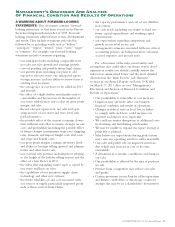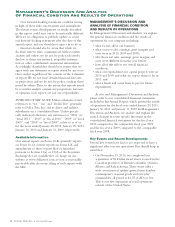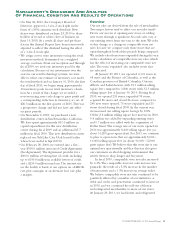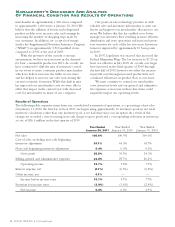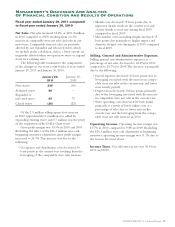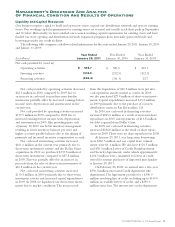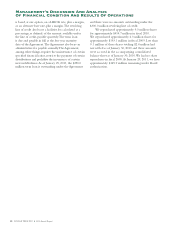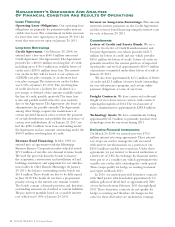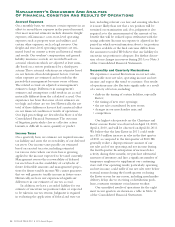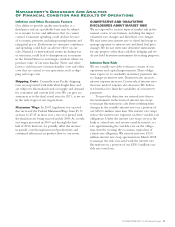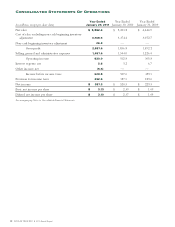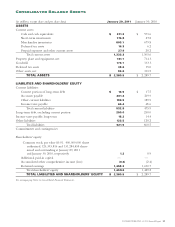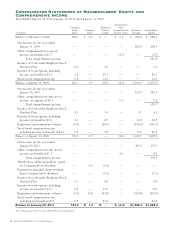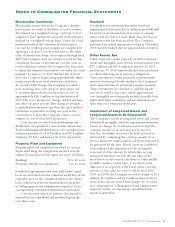Dollar Tree 2010 Annual Report Download - page 25
Download and view the complete annual report
Please find page 25 of the 2010 Dollar Tree annual report below. You can navigate through the pages in the report by either clicking on the pages listed below, or by using the keyword search tool below to find specific information within the annual report.Management’s Discussion And Analysis
Of Financial Condition And Results Of Operations
including estimates of future merchandise markdowns
and shrink, which signifi cantly affect the ending
inventory valuation at cost as well as the resulting gross
margins. The averaging required in applying the retail
inventory method and the estimates of shrink and
markdowns could, under certain circumstances, result
in costs not being recorded in the proper period.
We estimate our markdown reserve based on the
consideration of a variety of factors, including, but
not limited to, quantities of slow moving or seasonal,
carryover merchandise on hand, historical markdown
statistics and future merchandising plans. The accuracy
of our estimates can be affected by many factors, some
of which are outside of our control, including changes
in economic conditions and consumer buying trends.
Historically, we have not experienced signifi cant
differences in our estimated reserve for markdowns
compared with actual results.
Our accrual for shrink is based on the actual,
historical shrink results of our most recent physical
inventories adjusted, if necessary, for current economic
conditions and business trends. These estimates are
compared to actual results as physical inventory counts
are taken and reconciled to the general ledger. Our
physical inventory counts are generally taken between
January and September of each year; therefore, the
shrink accrual recorded at January 29, 2011 is based
on estimated shrink for most of 2010, including the
fourth quarter. We have not experienced signifi cant
fl uctuations in historical shrink rates beyond approxi-
mately 10-20 basis points in our Dollar Tree stores
for the last few years. However, we have sometimes
experienced higher than typical shrink in acquired
stores in the year following an acquisition. We periodi-
cally adjust our shrink estimates to address these factors
as they become apparent.
Our management believes that our application
of the retail inventory method results in an inventory
valuation that reasonably approximates cost and results
in carrying inventory at the lower of cost or market
each year on a consistent basis.
In March 2011, we entered into fuel derivative
contracts for approximately 2.8 million gallons of
diesel fuel, or approximately 50% of our fuel needs
from August 2011 through January 2012.
Critical Accounting Policies
The preparation of fi nancial statements requires the
use of estimates. Certain of our estimates require
a high level of judgment and have the potential to
have a material effect on the fi nancial statements if
actual results vary signifi cantly from those estimates.
Following is a discussion of the estimates that we
consider critical.
Inventory Valuation
As discussed in Note 1 to the Consolidated Financial
Statements, inventories at the distribution centers are
stated at the lower of cost or market with cost deter-
mined on a weighted-average basis. Cost is assigned to
store inventories using the retail inventory method on
a weighted-average basis. Under the retail inventory
method, the valuation of inventories at cost and the
resulting gross margins are computed by applying a
calculated cost-to-retail ratio to the retail value of
inventories. From our inception and through fi scal
2009, we used one inventory pool for this calculation.
Because of our investments over the years in our
retail technology systems, we were able to refi ne our
estimate of inventory cost under the retail method and
on January 31, 2010, the fi rst day of fi scal 2010, we
began using approximately 30 inventory pools in our
retail inventory calculation. As a result of this change,
we recorded a non-recurring, non-cash charge to gross
profi t and a corresponding reduction in inventory, at
cost, of approximately $26.3 million in the fi rst quarter
of 2010. The retail inventory method is an averaging
method that has been widely used in the retail industry
and results in valuing inventories at lower of cost or
market when markdowns are taken as a reduction of
the retail value of inventories on a timely basis.
Inventory valuation methods require certain
signifi cant management estimates and judgments,
DOLLAR TREE, INC. ♦ 2010 Annual Report 23


